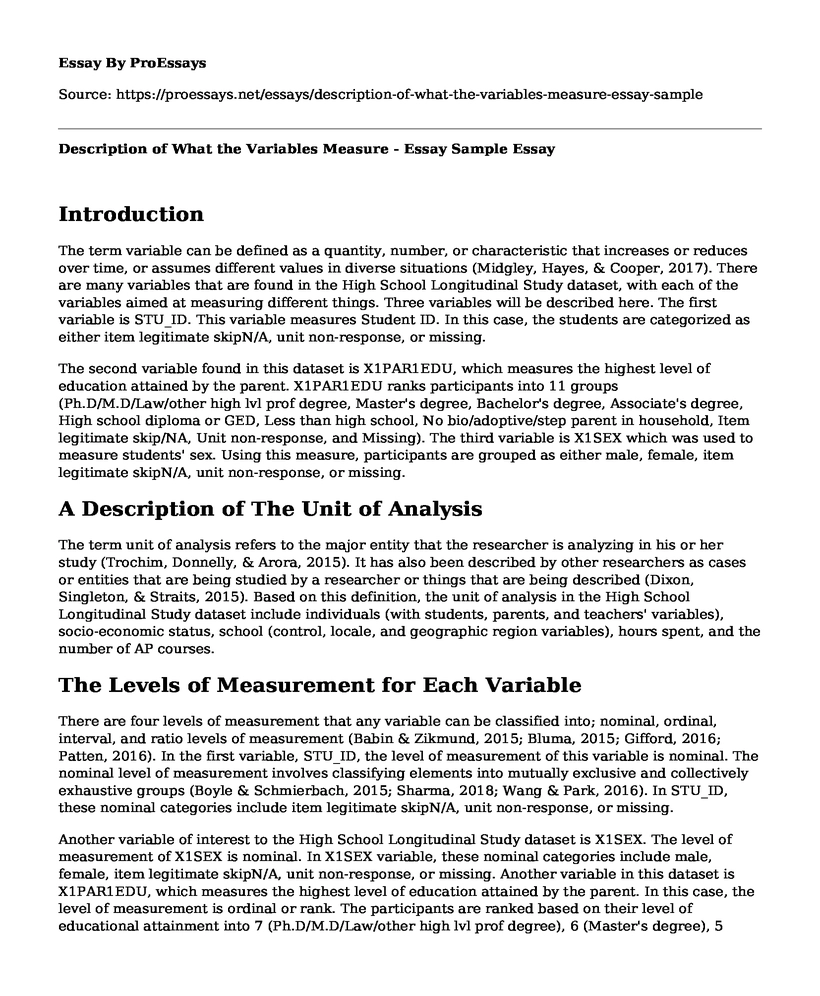Introduction
The term variable can be defined as a quantity, number, or characteristic that increases or reduces over time, or assumes different values in diverse situations (Midgley, Hayes, & Cooper, 2017). There are many variables that are found in the High School Longitudinal Study dataset, with each of the variables aimed at measuring different things. Three variables will be described here. The first variable is STU_ID. This variable measures Student ID. In this case, the students are categorized as either item legitimate skipN/A, unit non-response, or missing.
The second variable found in this dataset is X1PAR1EDU, which measures the highest level of education attained by the parent. X1PAR1EDU ranks participants into 11 groups (Ph.D/M.D/Law/other high lvl prof degree, Master's degree, Bachelor's degree, Associate's degree, High school diploma or GED, Less than high school, No bio/adoptive/step parent in household, Item legitimate skip/NA, Unit non-response, and Missing). The third variable is X1SEX which was used to measure students' sex. Using this measure, participants are grouped as either male, female, item legitimate skipN/A, unit non-response, or missing.
A Description of The Unit of Analysis
The term unit of analysis refers to the major entity that the researcher is analyzing in his or her study (Trochim, Donnelly, & Arora, 2015). It has also been described by other researchers as cases or entities that are being studied by a researcher or things that are being described (Dixon, Singleton, & Straits, 2015). Based on this definition, the unit of analysis in the High School Longitudinal Study dataset include individuals (with students, parents, and teachers' variables), socio-economic status, school (control, locale, and geographic region variables), hours spent, and the number of AP courses.
The Levels of Measurement for Each Variable
There are four levels of measurement that any variable can be classified into; nominal, ordinal, interval, and ratio levels of measurement (Babin & Zikmund, 2015; Bluma, 2015; Gifford, 2016; Patten, 2016). In the first variable, STU_ID, the level of measurement of this variable is nominal. The nominal level of measurement involves classifying elements into mutually exclusive and collectively exhaustive groups (Boyle & Schmierbach, 2015; Sharma, 2018; Wang & Park, 2016). In STU_ID, these nominal categories include item legitimate skipN/A, unit non-response, or missing.
Another variable of interest to the High School Longitudinal Study dataset is X1SEX. The level of measurement of X1SEX is nominal. In X1SEX variable, these nominal categories include male, female, item legitimate skipN/A, unit non-response, or missing. Another variable in this dataset is X1PAR1EDU, which measures the highest level of education attained by the parent. In this case, the level of measurement is ordinal or rank. The participants are ranked based on their level of educational attainment into 7 (Ph.D/M.D/Law/other high lvl prof degree), 6 (Master's degree), 5 (Bachelor's degree), 4 (Associate's degree), 3 (High school diploma or GED), 2 (Less than high school,), 0 (No bio/adoptive/step parent in household), -7 (Item legitimate skip/NA), -8 (Unit non-response), and -9 (Missing).
How the Variables Can Be Used to Answer a Social Change Question and Implications
The variables found in the High School Longitudinal Study dataset can be used to address a social change question such as the relationship between parental educational level and impact on student's science self-efficacy. If a research study is carried out and a positive relationship between parental educational level and student's science self-efficacy is established, it means that students whose parents have a higher level of education are more likely to have higher science self-efficacy. Such findings imply that teachers can devise a means of enhancing the level of science self-efficacy, especially in students whose parents have a low level of educational attainment.
References
Babin, B. J., & Zikmund, W. G. (2015). Essentials of marketing research. Boston, MA: Cengage Learning.
Bluma. (2015). Elementary statistic, bluma: elementary statistic. New York, NY: McGraw-Hill Publishers.
Boyle, M., & Schmierbach, M. (2015). Applied communication research methods: getting started as a researcher. New York, NY: Routledge.
Dixon, J. C., Singleton, R., & Straits, B. C. (2015). The process of social research. Oxford, UK: Oxford University Press.
Gifford, R. (2016). Research methods for environmental psychology. Hoboken, NJ: John Wiley & Sons.
Midgley, N., Hayes, J., & Cooper, M. (2017). Essential research findings in child and adolescent counselling and psychotherapy. Thousand Oaks, CA: Sage Publications.
Patten, M. L. (2016). Understanding research methods: an overview of the essentials. Abingdon, UK: Taylor & Francis.
Sharma, J. K. (2018). Business statistics, 4th edition. Noida, India: Vikas Publishing House.Trochim, Donnelly, & Arora, K. (2015). Research methods: the essential knowledge base. Boston, MA: Cengage Learning.
Wang, G. T., & Park, K. (2016). Student research and report writing: from topic selection to the complete paper. Hoboken, NJ: John Wiley & Sons.
Cite this page
Description of What the Variables Measure - Essay Sample. (2022, Nov 27). Retrieved from https://proessays.net/essays/description-of-what-the-variables-measure-essay-sample
If you are the original author of this essay and no longer wish to have it published on the ProEssays website, please click below to request its removal:
- Narrative Essay: A Bad Monday Morning
- Andragogy in Adult Learning Paper Example
- A Soundtrack for My Life Essay Example
- The Relationship Between Socio-Economic Status and Early Childhood Development - Essay Sample
- Essay Sample on Leadership, Critical Thinking and Intellectual Courage
- Essay Sample on Cross-Channel Student Outreach: Social Media Strategy
- Paper Example on Uprooting White Supremacy Culture: Ensuring Racial Equity in Schools







